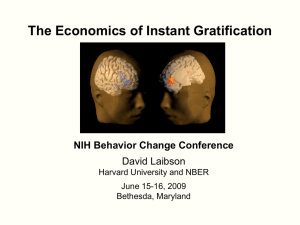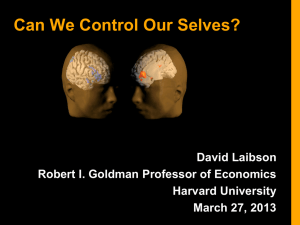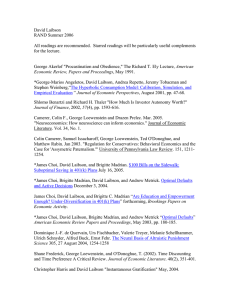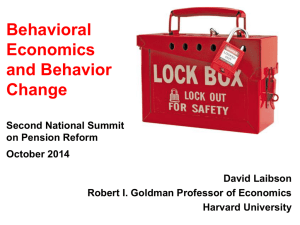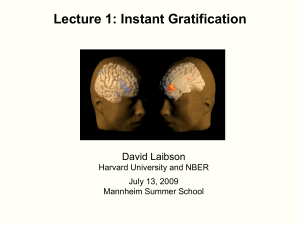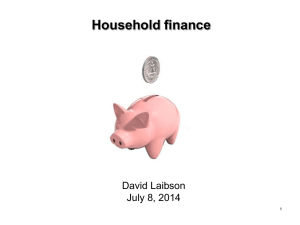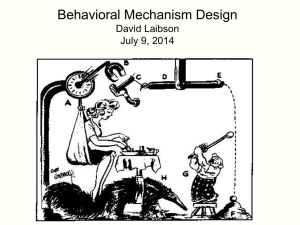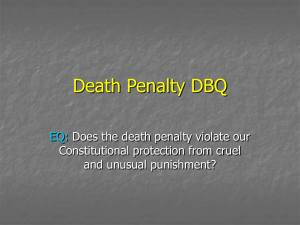Present-Biased II--Evidence
advertisement
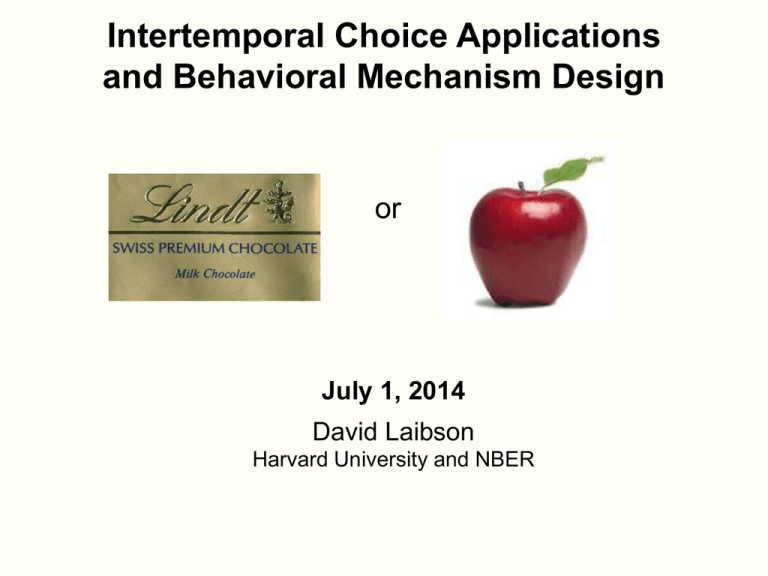
Intertemporal Choice Applications and Behavioral Mechanism Design or July 1, 2014 David Laibson Harvard University and NBER Outline 1. Preference reversals 2. Commitment 3. Other types of studies 1. Preference reversals Quasi-hyperbolic discounters will tend to choose patiently when choosing for the future and impatiently when choosing for the present. D( ) D( 1) 1 Future discount rate = 1 0.05 D( ) D(0) D(1) 1 Present discount rate = 1 0.5 D(0) 1 Read, Loewenstein & Kalyanaraman (1999) Choose among 24 movie videos • Some are “low brow”: Four Weddings and a Funeral • Some are “high brow”: Schindler’s List • Picking for tonight: 66% of subjects choose low brow. • Picking for next Tuesday: 37% choose low brow. • Picking for second Tuesday: 29% choose low brow. Tonight I want to have fun… next week I want things that are good for me. Read and van Leeuwen (1998) Choosing Today Eating Next Week Time If you were deciding today, would you choose fruit or chocolate for next week? Patient choices for the future: Choosing Today Eating Next Week Time Today, subjects typically choose fruit for next week. 74% choose fruit Impatient choices for today: Choosing and Eating Simultaneously Time If you were deciding today, would you choose fruit or chocolate for today? Time Inconsistent Preferences: Choosing and Eating Simultaneously Time 70% choose chocolate Percentage unhealthy snacks chosen H = hungry (late afternoon) S = sated (just after lunch) immediate advance immediate advance immediate advance immediate advance See Badger et al (2007) for a related example with heroin addicts given the timedated reward of buprenorphine (“bup”), a heroin partial agonist small sample warning (n=13) Extremely thirsty subjects McClure, Ericson, Laibson, Loewenstein and Cohen (2007) • Choosing between, juice now or 2x juice in 5 minutes 60% of subjects choose first option. • Choosing between juice in 20 minutes or 2x juice in 25 minutes 30% of subjects choose first option. • We estimate that the 5-minute discount rate is 50% and the “long-run” discount rate is 0%. • Ramsey (1930s), Strotz (1950s), & Herrnstein (1960s) were the first to understand that discount rates are higher in the short run than in the long run. Money now vs. money later Thaler (1981) • • • • Hypothetical rewards (but many experiments use real rewards) Baseline exponential discounting model: Y = t X So -ln = (1/t) ln [X/Y], remember that t is in units of yrs What amount makes you indifferent between $15 today and $X in 1 month? X = 20 -ln = (1/t) ln [X/15] = 12 ln [X/15] = 345% per year • What amount makes you indifferent between $15 today and $X in ten years? X = 100 -ln = (1/t) ln [X/15] = (1/10) ln [X/15] = 19% per year But … “money earlier vs. money later” (MEL) has so many confounds (Chabris, Laibson, and Schuldt 2009) • Unreliability of future rewards (trust; bird in the hand; Andreoni and Sprenger 2010) • Investment vs. consumption (money receipt at date t is not timestamped utils event at date t) • Transaction costs (especially when asymmetric) • Curvature of utility function (see Harrison et al for partial fixes) • Framing and demand characteristics (e.g., response scale; Beauchamp et al 2013) • Sub-additivity (Read, 2001; Benhabib, Bisin, and Schotter 2008) • (Hypothetical rewards) • Psychometric heuristics (Rubinstein 1988, 2003; Read et al 2011; White et al 2014) Why are money questions unsuited to measuring discounting even in theory? • If an agent is not liquidity constrained, she should maximize NPV when asked about money now vs. money later. • Note that NPV is based on market interest rates, not time preferences. • After maximizing NPV, she should pick her indifference point using time preferences. Separation theorem: pick payment to maximize NPV, regardless of time preference (then locate along efficient frontier) Later $7 later o o u '(cNow ) slope MRS u '(cLater ) slope = -(1+r) o $5 now Now White, Ericson, Laibson, and Cohen (2014) (see also Read, Frederick and Scholten 2013) • Proportional reasoning explains inter-temporal choices in MEL tasks much better than discounting models (including present-biased discounting). • Probability of choosing larger, later reward (x2,t2) over smaller, earlier reward (x1,t1). x 2 x1 t 2 t1 Logit 0 1( x 2 x1) 2 3(t 2 t1) 4 * * x t [ • Improvement of 6 percentage points of predictive accuracy in cross-validation study (i.e., out of sample prediction) ] Augenblick, Niederle, and Sprenger (2012) “Three period work experiment: 0, 2, 3” • At date 0: How hard do you want at work at 2 and at 3? • At date 2: How hard do you want to work at 2 and at 3? • At date 2, subjects tend to shift work from 2 to 3. • Estimated parameters: β = 0.927; δ = 0.997 • Subjects are willing to commit at date 0 (48/80 commit). • For those who commit: β = 0.881; δ = 1.004 Augenblick, Niederle, and Sprenger (2012) “Three period money experiment: 1, 4, 7” • At date 1: How much money do you want at 4 and at 7? • At date 4: How much money do you want at 4 and at 7? • At date 4, subjects don’t shift money to 4 from 7. • Estimated parameters: β = 0.974; δ = 0.998. Augenblick, Niederle, and Sprenger (2012) • Limited preference reversals in the domain of money (as predicted by the model of present bias) • Present bias observed in the “consumption” version of the experiment. Outline 1. Preference reversals 2. Commitment 3. Other evidence Stickk Ayres, Goldberg and Karlan: Stickk.com Clocky Shreddy™ SNUZ N LUZ Tocky Ashraf, Karlan, and Yin (2006) • Offered a commitment savings product to randomly chosen clients of a Philippine bank • 28.4% take-up rate of commitment product (either date-based goal or amount-based goal) • More “hyperbolic” subjects are more likely to take up the product • After twelve months, average savings balances increased by 81% for those clients assigned to the treatment group relative to those assigned to the control group. Gine, Karlan, Zinman (2009) • Tested a voluntary commitment product (CARES) for smoking cessation. • Smokers offered a savings account in which they deposit funds for six months, after which take urine tests for nicotine and cotinine. • If they pass, money is returned; otherwise, forfeited • 11% of smokers offered CARES take it up, and smokers randomly offered CARES were 3 percentage points more likely to pass the 6-month test than the control group • Effect persisted in surprise tests at 12 months. Kaur, Kremer, and Mullainathan (2010): Compare two piece-rate contracts: 1. Linear piece-rate: w per unit produced 2. Linear piece-rate with penalty if worker does not achieve production target T (“Commitment”) – Earn w/2 for each unit produced if production < T – Jump up at T, returning to baseline contract Earnings Never earn more under commitment contract May earn ½ as much T Production Kaur, Kremer, and Mullainathan (2012): • Demand for Commitment: Commitment contract (Target > 0) chosen 35% of the time • Effect on Production: Being offered commitment contract increases average production by 2.3% relative to control • Among all participants, being offered the commitment contract is equivalent (in output effect) to a 7% increase in the piece-rate wage • Participants above the mean pay-day cycle sensitivity are 49% more likely to demand commitment and their productivity increase is 9% (equivalent to a 27% increase in wage) Houser, Schunk, Winter, and Xiao (2010) • In a laboratory setting, 36.4% of subjects are willing to use a commitment device to prevent them from surfing the web during a work task Royer, Stehr, and Sydnor (2011) • Commit to go to the gym at least once every 14 calendar days (8 week commitment duration) • Money at stake is choice of participant. • Money donated to charity in event of failure. • Fraction taking commitment contract: – Full sample: 13% – Gym Members: 25% – Gym Non-members: 6% • Average commitment = $63; max = $300, 25th pct = $20; 75th pct = $100. Ariely and Wertenbroch (2002) Proofreading tasks: "Sexual identity is intrinsically impossible," says Foucault; however, according to de Selby[1], it is not so much sexual identity that is intrinsically impossible, but rather the dialectic, and some would say the satsis, of sexual identity. Thus, D'Erlette[2] holds that we have to choose between premodern dialectic theory and subcultural feminism imputing the role of the observor as poet.“ • Evenly spaced deadlines ($20) • Self-imposed deadlines ($13) – subjects in this condition could self-impose costly deadlines ($1 penalty for each day of delay) and 37/51 do so. • End deadline ($5) Alsan, Armstrong, Beshears, Choi, del Rio, Laibson, Madrian and Marconi (2014) Voluntary Commitment Arm Get paid $30 per clinical Get paid $30 per clinical visit, whether or not you visit, only if you are are medically adherent. medically adherent 32% Low Hurdle Arm Get paid $30 per clinical visit, whether or not you are medically adherent. 68% small sample warning (n=40) Voluntary commitment arm IC CCT Low hurdle arm Proportion Suppressed 1.0 0.8 0.6 0.4 0.2 0.0 12 mo 9 mo 6 mo Months Prior to Enrollment 3 mo V1 Enrollment Visit V2 V3 V4 Incentivized Visits V5 V6 PostIncentivized Visit How to design a commitment contract Participants divide $$$ between: • Freedom account (22% interest) • Goal account (22% interest) – withdrawal restriction Beshears, Choi, Harris, Laibson, Madrian, Sakong (2014) Initial investment in goal account Goal Account 10% penalty Goal account 20% penalty Goal account No withdrawal 35% 43% 56% 65% Freedom Account 57% Freedom Account 44% Freedom Account Now participant can divided their money across three accounts: (i) freedom account (ii) goal account with 10% penalty (iii) goal account with no withdrawal 49.9% allocated to freedom account 16.2% allocated to 10% penalty account 33.9% allocated to no withdrawal account Beshears, Choi, Harris, Laibson, Madrian, Sakong (2014) Outline 1. Preference reversals 2. Commitment 3. Other evidence Dellavigna and Malmendier (2004, 2006) • • • • Average cost of gym membership: $75 per month Average number of visits: 4 Average cost per vist: $19 Cost of “pay per visit”: $10 Oster and Scott-Morton (2004) • People (and other vice magazines) sold on the news stand at a high price relative to subscription • Foreign Affairs (and other investment magazines) sold on the news stand at a low price relative to subscription • But People (and other vice magazines) sold disproportionately on the news stand and Foreign Affairs (and other investment magazines) sold disproportionately by subscription. Sampling of other studies • • • • • • • • Della Vigna and Paserman (2005): job search Duflo (2009): immunization Duflo, Kremer, Robinson (2009): commitment fertilizer Truck driver study Milkman et al (2008): video rentals return sequencing Sapienza and Zingales (2008,2009): procrastination Trope & Fischbach (2000): commitment to medical adherence Wertenbroch (1998): individual packaging of temptation goods Household finance studies • Angeletos, Laibson, Repetto, Tobacman, and Weinberg (2001) • Della Vigna and Paserman (2005): job search • Duflo, Kremer, Robinson (2009): commitment fertilizer • Meier and Sprenger (2010): correlation with credit card borrowing • Shui and Ausubel (2006): credit cards • Shapiro (2005): consumption cycle over month • Mastrobuoni and Weinberg (2009): consumption cycle over the month • Laibson, Repetto, and Tobacman (2012): MSM estimation using wealth and debt moments • Kuchler (2014): credit card debt paydown Outline 1. Preference reversals 2. Commitment 3. Other types of studies END LECTURE HERE Shapiro (2005) • For food stamp recipients, caloric intake declines by 10-15% over the food stamp month. • To be resolved with exponential discounting, requires an annual discount factor of 0.23 • Survey evidence reveals rising desperation over the course of the food stamp month, suggesting that a high elasticity of intertemporal substitution is not a likely explanation. • Households with more short-run impatience (estimated from hypothetical intertemporal choices) are more likely to run out of food sometime during the month. The data can reject a number of alternative hypotheses. • Households that shop for food more frequently do not display a smaller decline in intake over the month, casting doubt on depreciation stories. • Individuals in single-person households experience no less of a decline in caloric intake over the month than individuals in multi-person households. • Survey respondents are not more likely to eat in another person’s home toward the end of the month. • The data show no evidence of learning over time Social security Mastrobuoni and Weinberg (2009) • Individuals with substantial savings smooth consumption over the monthly pay cycle • Individuals without savings consume 25 percent fewer calories the week before they receive checks relative to the week afterwards Laibson, Repetto, and Tobacman (2007) Use MSM to estimate discounting parameters: – Substantial illiquid retirement wealth: W/Y = 3.9. – Extensive credit card borrowing: • 68% didn’t pay their credit card in full last month • Average credit card interest rate is 14% • Credit card debt averages 13% of annual income – Consumption-income comovement: • Marginal Propensity to Consume = 0.23 (i.e. consumption tracks income) LRT Simulation Model • • • • • • • • Stochastic Income Lifecycle variation in labor supply (e.g. retirement) Social Security system Life-cycle variation in household dependents Bequests Illiquid asset Liquid asset Credit card debt • Numerical solution (backwards induction) of 90 period lifecycle problem. LRT Results: Ut = ut + [ut+1 2ut+2 3ut+3 ...] = 0.70 (s.e. 0.11) = 0.96 (s.e. 0.01) Null hypothesis of = 1 rejected (t-stat of 3). Specification test accepted. Moments: %Visa: Visa/Y: MPC: f(W/Y): Empirical 68% 13% 23% 2.6 Simulated (Hyperbolic) 63% 17% 31% 2.7 LRT Intuition • Long run discount rate is –ln() = 4%, so save in long-run (illiquid) assets. • Short-run discount rate is –ln() 40%, so borrow on your credit card today. • Indeed, you might even borrow on your credit card so you can “afford” to save in your 401(k) account. Outline 1. 2. 3. 4. Preference reversals Commitment Other evidence Behavioral Mechanism Design Behavioral mechanism design 1. 2. 3. Specify a social welfare function (not necessarily based on revealed preference) Specify a theory of consumer/firm behavior (consumers and/or firms may not behave optimally). Solve for the institutional regime that maximizes the social welfare function, conditional on the theory of consumer/firm behavior. 71 Today: Two examples of behavioral mechanism design A. Optimal defaults B. Optimal illiquidity 72 A. Optimal Defaults – public policy Mechanism design problem in which policy makers set a default for agents with present bias Carroll, Choi, Laibson, Madrian and Metrick (2009) 73 Basic set-up of problem Specify (dynamically consistent) social welfare function of planner (e.g., set β=1) Specify behavioral model of households Flow cost of staying at the default Effort cost of opting-out of the default Effort cost varies over time option value of waiting to leave the default Present-biased preferences procrastination Planner picks default to optimize social welfare function 74 Specific Details • Agent needs to do a task (once). – • • Until task is done, agent losses L(s* d ) per period. Doing task costs c units of effort now. – • • • • * Switch savings rate, s, from default, d, to optimal savings rate, s . Think of c as opportunity cost of time Each period c is drawn from a uniform distribution on [0,1]. Agent has present-biased discount function with β < 1 and δ = 1. So discount function is: 1, β, β, β, … Agent has sophisticated (rational) forecast of her own future behavior. She knows that next period, she will again have the weighting function 1, β, β, β, … Timing of game 1. Period begins (assume task not yet done) 2. Pay cost θ (since task not yet done) 3. Observe current value of opportunity cost c (drawn from uniform distribution) 4. Do task this period or choose to delay again? 5. It task is done, game ends. 6. If task remains undone, next period starts. Pay cost θ Period t-1 Observe current value of c Period t Do task or delay again Period t+1 Sophisticated procrastination • There are many equilibria of this game. • Let’s study the equilibrium in which sophisticates act whenever c < c*. We need to solve for c*. • Let V represent the expected undiscounted cost if the agent decides not to do the task at the end of the current period t: Likelihood of doing it in t+1 Likelihood of not doing it in t+1 c* V c *) 1 c *)V 2 Cost you’ll pay for certain in t+1, since job not yet done Expected cost conditional on drawing a low enough c* so that you do it in t+1 Expected cost starting in t+2 if project was not done in t+1 • In equilibrium, the sophisticate needs to be exactly indifferent between acting now and waiting. c* V [ (c*)(c */2) (1 c*)V ] • Solving for c* , we find: c* • Expected delay is: 1 1 2 E [ delay ] 1 c * 2 1 c *) c * 3 1 c *) c * 2 E [ delay ] 1 c * 2 1 c *) c * 3 1 c *) c * 2 1 1 c *) 1 c *)2 1 c *)3 1 c *) 1 c *)2 1 c *)3 c* 2 3 1 c *) 1 c *) 2 1 c *) 1 c *) 1 c* 1 1 c *) 1 1 c *) 1 1 c *) 1 1 1 c * 1 1 c *) 1 1 c *) c * 1 1 2 How does introducing β < 1 change the expected delay time? 1 E [ delay given 1] E [ delay given =1] 1 2 1 1 1 2 1 1 2 2 1 1 1 1 2 If β=2/3, then the delay time is scaled up by a factor of 2. In other words, it takes 2 times longer than it “should” to finish the project A model of procrastination: naifs • • • • Same assumptions as before, but… Agent has naive forecasts of her own future behavior. She thinks that future selves will act as if β = 1. So she (mistakenly) thinks that future selves will pick an action threshold of c* 1 1 2 2 • In equilibrium, the naif needs to be exactly indifferent between acting now and waiting. c ** V [ (c*)(c * /2) (1 c*)V ] 2 2 / 2 1 ) 2 1 2 V • To solve for V, recall that: c* V c *) 1 c *)V 2 ) 2 1 2 V 2 ) 2 V • Substituting in for V: c ** 2 1 2 ) 2 2 • So the naif uses an action threshold (today) of c ** 2 • But anticipates that in the future, she will use a higher threshold of c* 2 • So her (naïve) forecast of delay is: 1 1 Forecast [ delay] c* 2 • And her actual delay will be: 1 1 1 True [delay] c ** 2 2 • Being naïve, scales up her delay time by an additional factor of 1/β. Summary 1 . 2 • If β = 1, expected delay is • If β < 1 and sophisticated, expected delay is 2 1 1 2 ) 1 2 Note that 1 2 1 1. 2 2 2 1 • If β < 1 and naïve, anticipated delay is . 2 • If β < 1 and naïve, true delay is 1 1 2 2 ) 2 > 1 2 Note that 2 ) 1. That completes theory of consumer behavior. Now solve for government’s optimal policy. • Now we need to solve for the optimal default, d. min E* V ( s , d ) * d s • Note that the government’s objective ignores present bias, since it uses V as the welfare criterion. Optimal ‘Defaults’ Two classes of optimal defaults emerge from this calculation Automatic enrollment Optimal when employees have relatively homogeneous savings preferences (e.g. match threshold) and relatively little propensity to procrastinate “Active Choice” — require individuals to make a choice (eliminate the option to passively accept a default) Optimal when employees have relatively heterogeneous savings preferences and relatively strong tendency to procrastinate Key point: sometimes the best default is no default. 88 Preference Heterogeneity High Heterogeneity 30% Offset Default Low Heterogeneity Active Choice Center Default 0% 0 Beta 1 Lessons from theoretical analysis of defaults Defaults should be set to maximize average wellbeing, which is not the same as saying that the default should be equal to the average preference. Endogenous opting out should be taken into account when calculating the optimal default. The default has two roles: causing some people to opt out of the default (which generates costs and benefits) implicitly setting savings policies for everyone who sticks with the default 90 Empirical evidence on active choice Carroll, Choi, Laibson, Madrian, Metrick (2009) Active choice mechanisms require employees to make an active choice about 401(k) participation. Welcome to the company You are required to submit this form within 30 days of hire, regardless of your 401(k) participation choice If you don’t want to participate, indicate that decision If you want to participate, indicate your contribution rate and asset allocation Being passive is not an option 91 401(k) participation by tenure Fraction of employees ever participated 100% 80% 60% 40% 20% 0% 0 6 12 18 24 30 36 42 Tenure at company (months) Active decision cohort 48 Standard enrollment cohort 54 92 Active choice in 401(k) plans Active decision raises 401(k) participation. Active decision raises average savings rate by 50 percent. Active decision doesn’t induce choice clustering. Under active decision, employees choose savings rates that they otherwise would have taken three years to achieve. (Average level as well as the multivariate covariance structure.) 93 Other active choice interventions Active choice in asset allocation (Choi, Laibson, and Madrian 2009) Active choice in home delivery of chronic medications (Beshears, Choi, Laibson, Madrian 2011) 94 The Flypaper Effect in Individual Investor Asset Allocation (Choi, Laibson, Madrian 2009) Studied a firm that used several different match systems in their 401(k) plan. I’ll discuss two of those regimes today: Match allocated to employer stock and workers can reallocate Call this “default” case (default is employer stock) Match allocated to an asset actively chosen by workers; workers required to make an active designation. Call this “active choice” case (workers must choose) Economically, these two systems are identical. They both allow workers to do whatever the worker wants. Consequences of the two regimes Balances in employer stock Match Defaults into Employer Stock Active choice Own Balance in Employer Stock 24% 20% Matching Balance in Employer Stock 94% 27% Total Balance in Employer Stock 56% 22% 96 Use Active Choice to encourage adoption of Home Delivery of chronic medication Beshears, Choi, Laibson, and Madrian (2012) • • • • • • • Voluntary No plan design change Lower employee co-pay Time saving for employee Lower employer cost Better medication adherence Improved safety Member Express Scripts Scientific Advisory Board Member Express Scripts Scientific Advisory Board (Payments donated to charity by Express Scripts.) (All payments donated to charity.) Results from pilot study on 54,863 employees without home delivery taking chronic medication Among those making an active choice: Fraction choosing home delivery: 52.2% Fraction choosing standard pharmacy pick-up: 47.8% Results from pilot study at one company Rxs by Mail* 350,000 300,000 After Annual Savings at pilot company 250,000 200,000 Plan $350,000+ 150,000 Members $820,000+ 100,000 50,000 0 * Annualized Before Total Savings $1,170,000+ B. Optimal illiquidity Beshears, Choi, Harris, Laibson, Madrian, and Sakong (2013) Basic set-up of problem • Specify (dynamically consistent) social welfare function of planner (e.g., set β=1) • Specify behavioral model of households – Present-biased consumption and (privately observed) high frequency taste shocks – Planner can’t distinguish legitimate consumption responding to a taste shock, and illegitimate consumption driven by present bias. • Planner picks default to optimize social welfare function 101 Generalization of Amador, Werning and Angeletos (2001), hereafter AWA: 1. 2. 3. Present-biased preferences Short-run taste shocks. A general commitment technology. Timing Period 0. An initial period in which a commitment mechanism is set up by self 0. Period 1. A taste shock, θ, is realized and privately observed. Consumption (c₁) occurs. Period 2. Final consumption (c₂) occurs. U₀ U₁ U₂ = = = βδθ u₁(c₁) + θ u₁(c₁) + βδ² u₂(c₂) βδ u₂(c₂) u₂(c₂) We restrict the distribution of θ, but this restriction admits all commonly used singlepeaked densities. Self 0 hands self 1 a budget set (subset of blue region) c2 y Max |Slope| < 1+𝝅 Budget set y c1 Interpretation: for every extra unit of c1, the agent must give up no more than 1+𝝅 units of c2. So 𝝅 is a max consumption penalty. Two-part budget set c2 c1* c2* slope = -1 * * c , c 1 2) slope = -(1+ ) * c c1* 2 1 c1 Theorem 1 Assume: Constant relative risk aversion utility Penalty bounded above by π Then, self 0 will set up two accounts: Fully liquid account Illiquid account with penalty π. Theorem 2: Assume log utility. Then the amount of money deposited in the illiquid account rises with the early withdrawal penalty. Goal account usage (Beshears et al 2013) Goal Account 10% penalty Goal account 20% penalty Goal account No withdrawal 35% 43% 56% 65% Freedom Account 57% Freedom Account 44% Freedom Account Theorem 3 (AWA): Assume self 0 can pick any consumption penalty. Then self 0 will set up two accounts: fully liquid account fully illiquid account (no withdrawals in period 1) Assume there are three accounts: one liquid one with an intermediate withdrawal penalty one completely illiquid Then all assets will be allocated to the liquid account and the completely illiquid account. When three accounts are offered Goal account No withdrawal 33.9% Freedom Account 16.2% Goal Account 10% penalty 49.9% 401(k) plans allow withdrawals (10% tax penalty) – is this the right balance between commitment and liquidity? How would household respond if 401(k) plans added another option – an illiquid account? Would they take it up and would this reduce leakage and raise welfare? What would an optimal system look like if at least some households are naïve? Summary of behavioral mechanism design 1. 2. 3. Specify a social welfare function (not necessarily based on revealed preference) Specify a theory of consumer/firm behavior (consumers and/or firms may not behave optimally). Solve for the institutional structure that maximizes the social welfare function, conditional on the theory of consumer/firm behavior. Examples: Optimal defaults and optimal illiquidity. 1. 2. 3. 4. Preference reversals Commitment Other evidence Behavioral Mechanism Design
